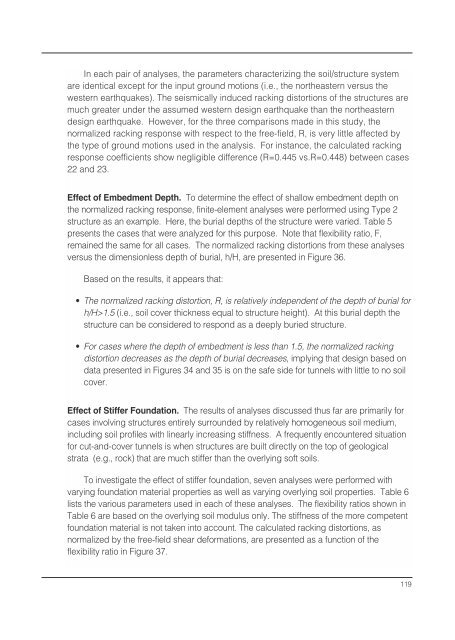Seismic Design of Tunnels - Parsons Brinckerhoff
Seismic Design of Tunnels - Parsons Brinckerhoff
Seismic Design of Tunnels - Parsons Brinckerhoff
You also want an ePaper? Increase the reach of your titles
YUMPU automatically turns print PDFs into web optimized ePapers that Google loves.
In each pair <strong>of</strong> analyses, the parameters characterizing the soil/structure system<br />
are identical except for the input ground motions (i.e., the northeastern versus the<br />
western earthquakes). The seismically induced racking distortions <strong>of</strong> the structures are<br />
much greater under the assumed western design earthquake than the northeastern<br />
design earthquake. However, for the three comparisons made in this study, the<br />
normalized racking response with respect to the free-field, R, is very little affected by<br />
the type <strong>of</strong> ground motions used in the analysis. For instance, the calculated racking<br />
response coefficients show negligible difference (R=0.445 vs.R=0.448) between cases<br />
22 and 23.<br />
Effect <strong>of</strong> Embedment Depth. To determine the effect <strong>of</strong> shallow embedment depth on<br />
the normalized racking response, finite-element analyses were performed using Type 2<br />
structure as an example. Here, the burial depths <strong>of</strong> the structure were varied. Table 5<br />
presents the cases that were analyzed for this purpose. Note that flexibility ratio, F,<br />
remained the same for all cases. The normalized racking distortions from these analyses<br />
versus the dimensionless depth <strong>of</strong> burial, h/H, are presented in Figure 36.<br />
Based on the results, it appears that:<br />
• The normalized racking distortion, R, is relatively independent <strong>of</strong> the depth <strong>of</strong> burial for<br />
h/H>1.5 (i.e., soil cover thickness equal to structure height). At this burial depth the<br />
structure can be considered to respond as a deeply buried structure.<br />
• For cases where the depth <strong>of</strong> embedment is less than 1.5, the normalized racking<br />
distortion decreases as the depth <strong>of</strong> burial decreases, implying that design based on<br />
data presented in Figures 34 and 35 is on the safe side for tunnels with little to no soil<br />
cover.<br />
Effect <strong>of</strong> Stiffer Foundation. The results <strong>of</strong> analyses discussed thus far are primarily for<br />
cases involving structures entirely surrounded by relatively homogeneous soil medium,<br />
including soil pr<strong>of</strong>iles with linearly increasing stiffness. A frequently encountered situation<br />
for cut-and-cover tunnels is when structures are built directly on the top <strong>of</strong> geological<br />
strata (e.g., rock) that are much stiffer than the overlying s<strong>of</strong>t soils.<br />
To investigate the effect <strong>of</strong> stiffer foundation, seven analyses were performed with<br />
varying foundation material properties as well as varying overlying soil properties. Table 6<br />
lists the various parameters used in each <strong>of</strong> these analyses. The flexibility ratios shown in<br />
Table 6 are based on the overlying soil modulus only. The stiffness <strong>of</strong> the more competent<br />
foundation material is not taken into account. The calculated racking distortions, as<br />
normalized by the free-field shear deformations, are presented as a function <strong>of</strong> the<br />
flexibility ratio in Figure 37.<br />
119
















